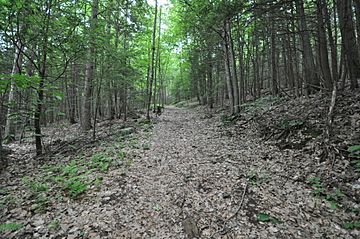Petticoat Hill facts for kids
Quick facts for kids Petticoat Hill |
|
|---|---|

A trail in the reservation
|
|
| Highest point | |
| Elevation | 1,180 ft (360 m) |
| Geography | |
| Location | Williamsburg, Massachusetts, United States |
| Parent range | The Berkshires |
| Climbing | |
| Easiest route | Loop trail to Scott Hill (subordinate summit) |
| Petticoat Hill | |
|---|---|
| Established | 1906 |
| Operator | The Trustees of Reservations |
| Website | Petticoat Hill |
Petticoat Hill is a beautiful hill in Williamsburg, Massachusetts. It stands 1,180 feet (361 meters) tall. Part of the hill is a special nature area called an open space reservation. This reservation covers 60 acres (about 24 hectares).
The reservation is on the east side of the hill. It is looked after by The Trustees of Reservations (TTOR). This group is a non-profit organization that works to protect nature. The hill and reservation have steep slopes. They are mostly covered with a type of forest called northern hardwood forest. You'll see many eastern hemlock trees here.
Contents
Exploring Petticoat Hill's Nature
Petticoat Hill rises almost 1,000 feet (300 meters) above downtown Williamsburg. It has two smaller peaks nearby. Scott Hill is 1,027 feet (313 meters) tall. The reservation and its trails are found on Scott Hill. Unquomonk Hill is 1,083 feet (330 meters) tall.
Water Flow and Rivers
Water from the east and south sides of Petticoat Hill flows into Unquomonk Brook. From there, it goes into the Mill River. The Mill River then joins the Connecticut River. Finally, the water reaches Long Island Sound. Water from the north and west sides of the hill flows into Meekin Brook, which also joins the Mill River.
Animals and Plants of Petticoat Hill
Petticoat Hill is home to many animals. You might see American black bears, coyotes, and white-tailed deer.
The reservation also has many beautiful plants. In spring, you can find colorful wildflowers. These include red trillium, trout lily, white baneberry, and wild ginger.
Many different types of trees grow here. Some common ones are American basswood, black birch, hornbeam, and Northern red oak. You'll also find pignut hickory, shagbark hickory, red maple, and sugar maple. Other trees include white ash and white pine. Some trees on the property are over 100 feet (30 meters) tall. Some are even 10 feet (3 meters) or more across!
The Story Behind Petticoat Hill
Petticoat Hill got its unique name from a local story. Long ago, a family with seven daughters lived on the hill. The story says that on Mondays, when they did laundry, they would hang their petticoats outside. These petticoats would "wave in the wind" and could be seen for miles around!
From Farms to Forests
In the early 1800s, the area around Petticoat Hill was very busy. It was the most populated part of Williamsburg. The land that is now the reservation was mostly used as sheep pasture. There was also a field full of large boulders.
Later in the 1800s, many farmers moved to the Midwest. Because of this, the land on Petticoat Hill slowly turned back into a forest. Today, you can still see old stone walls, foundations, and cellar holes. These are the only signs left of the farms that used to be there.
Protecting the Land
The east side of Petticoat Hill was given to The Trustees of Reservations in 1906. Mrs. Edward W. Nash donated the land to honor her husband. More land was added to the reservation in 1924.
Fun Things to Do at Petticoat Hill
The Petticoat Hill reservation is a great place to visit. You can go hiking and cross-country skiing there. It's also a nice spot for a picnic. During certain times of the year, hunting is allowed.
The Trustees of Reservations manages a 1.5-mile (2.4 km) loop trail. This trail goes through the property. There's another trail called Locke's Loop. This trail is managed by a local group called Williamsburg Woodland Trails. They have permission from private landowners to use their land. Locke's Loop connects with the reservation trail near the top of Scott Hill. It crosses the peak and then goes down through private land before returning to the reservation. There are no marked trails that go all the way to the very top of Petticoat Hill itself.

